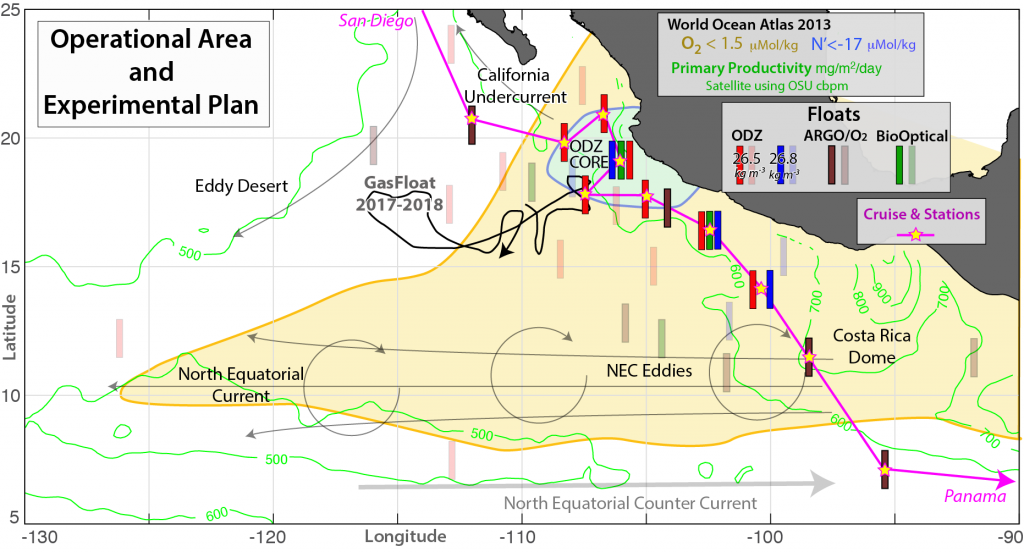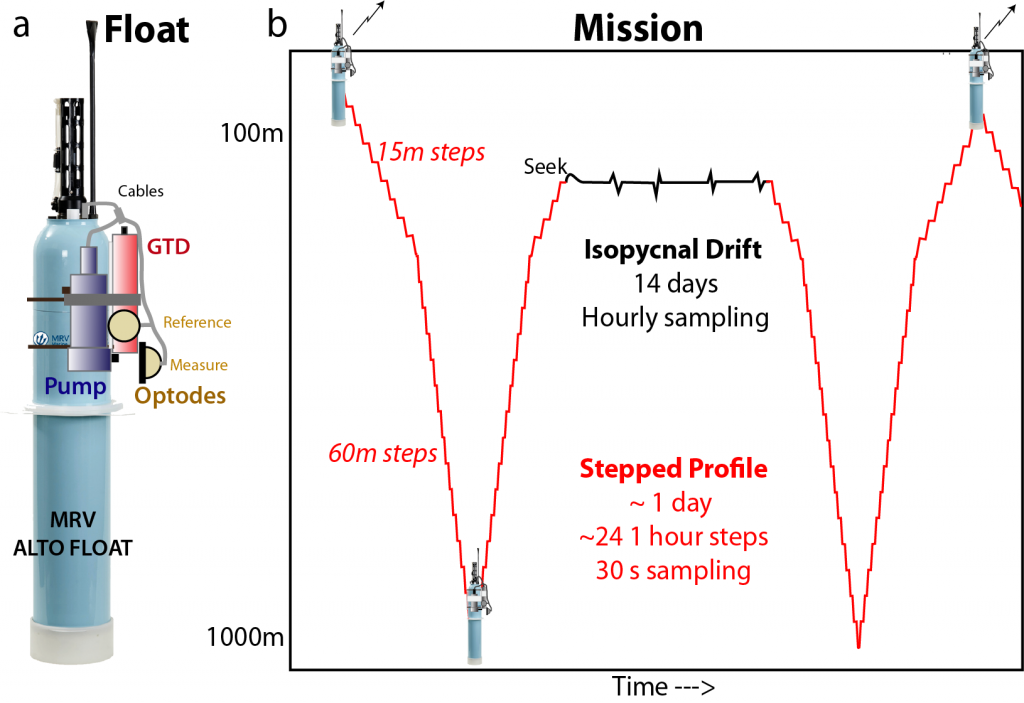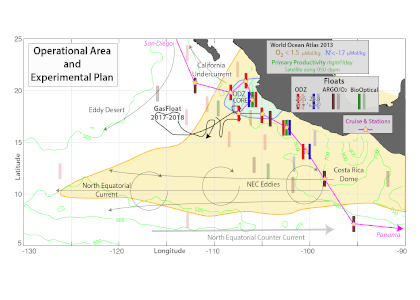By Mark A. Altabet (SMAST/U. Mass. Dartmouth), Craig McNeil, and Eric D’Asaro (both at APL / U. Washington)
Oxygen deficient zones (ODZs) constitute a small fraction of total oceanic volume yet play an important role in regulating global ocean carbon and nitrogen cycles. They are critical for regulating the ocean’s nitrogen budget, as loss of biologically available nitrogen to N2 gas (N-loss) within ODZs is estimated to be 30 to 50% of the global total. However, temporal and spatial variability in N-loss rates have been undersampled by ship-based process studies leaving substantial uncertainty in overall rates. While local and short-term regulation of N-loss by O2 and organic matter availability is well documented, little is known about the larger scale temporal/spatial variability in N-loss that may result from physical forcings such as remote ventilation, seasonal variability in vertical exchange with the near-surface layer, and mesoscale eddies. Understanding the impact of larger scale physical forcings on N-loss as mediated through O2 and organic flux is needed to fully understand the causes and consequences of any future ODZ expansion. To achieve this, we need sustained observations by a distributed array capable of detecting synoptic variability.
To address these issues, a new NSF-funded project will carry out a multiyear, autonomous float-based observational program to answer the following questions:
- How does biogenic N2 production in ODZs vary over weekly to annual time scales and space scales of 10s to 1000s km?
- What are the major scales of variability and their associated oceanographic phenomena and how do they relate to control by organic matter flux and O2 concentration?
- How does this variability influence regionally integrated N-loss?

Figure 1. The ETNP ODZ roughly defined by O2 <1.5 μmol/kg (orange, World Ocean Atlas 2013). Our new NSF-funded project will sample across these patterns of spatial and temporal variability for 2 years with 10 subsurface ODZ floats (red/blue) each measuring profiles of T, S, O2 (50 nmol/kg LOD) and N2 (0.1 μmol/kg precision), and the in situ rate of N2 change. Four Argo floats with O2 sensors and BioOptical floats provided by collaborators will supplement this array. Bright bar symbols are the planned deployment positions; dimmed bar symbols suggest possible displacements after 2 years. Ship-based measurements (yellow stars) along the deployment cruise track (magenta) will be used for float sensor calibration and identification of ETNP source water properties. The 2-year track of our prototype GasFloat is also shown (black line).
This project will exploit our ability to make in situ, ultra-high precision measurement of N2 concentration (~0.1 umol/kg) and use commercially available O2 sensors to measure O2 in the 10s of nM range. Our study area is the Eastern Tropical North Pacific (ETNP), the largest ODZ and the region of our successful pilot deployments (Figure 1). Over a multi-year period, our study will determine in situ nM-level O2 and biogenic N2 on float profiles distributed throughout the ETNP and encompassing geographic gradients in O2 and surface productivity. For the first time, our study will also determine in situ N-loss rates from changes in N2 concentration during one- to two-week Lagrangian float deployments drifting along a constant density surface (Figure 2). A pilot two-year float (‘GasFloat, Figure 1) deployment in the ETNP has documented our ability to do so. Critically, our float-based approach more closely matches the frequency and distribution of observations to the expected variability in biogenic N2 production, as compared to prior work. This study will also dramatically increase the data density in this region by acquiring >500 profiles/drifts for N2 and >1000 profiles for nM O2.

Figure 2. (a) Schematic of float system to be deployed (b) Example of float mission including 2-week isopycnal drift.
We anticipate float deployment in summer 2020 via a UNOLS vessel. Investigators interested in collaborative participation through contribution of autonomous instrumentation and/or making shipboard measurements are encouraged to contact the lead PI Mark Altabet at maltabet@umassd.edu. Similarly, students interested in graduate research opportunities through this project should contact the lead PI.





